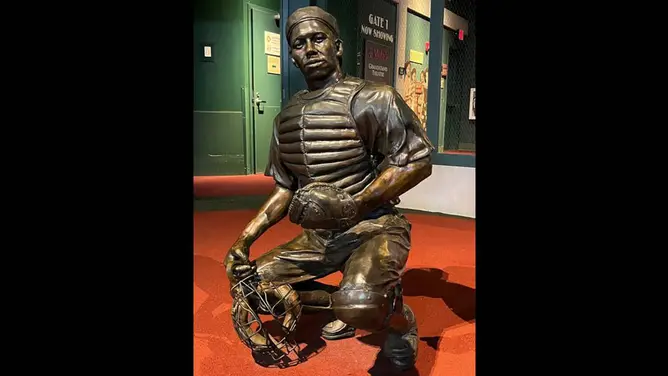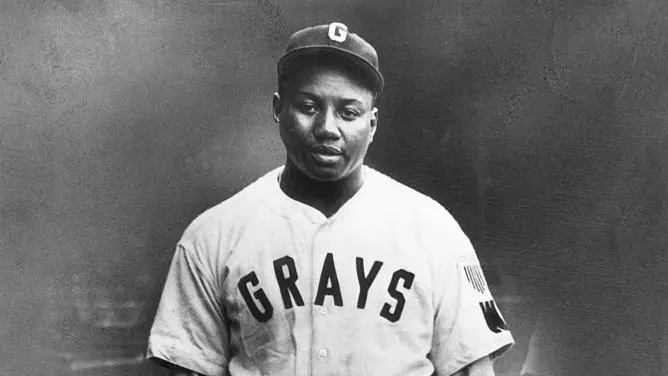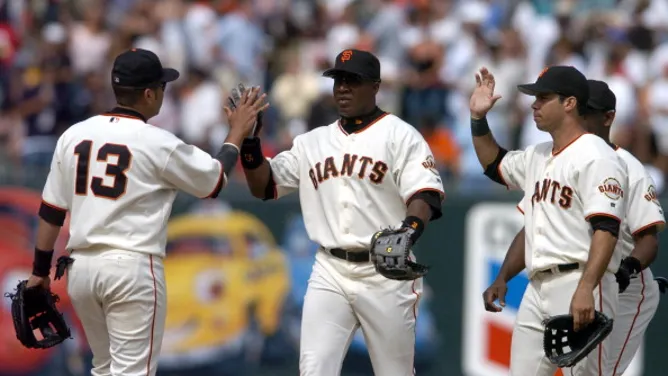Negro Leagues Entering MLB Records Nice Gesture, But It's More Fantasy League Than Practical | Glenn Guilbeau
Josh Gibson should have been the first black player to go from the Negro Leagues to Major League Baseball ahead of Jackie Robinson on April 15, 1947, with the Brooklyn Dodgers.
Gibson was a better and much more powerful, legendary, Ruthian player. But he died on Jan. 20, 1947, at age 35 of a stroke from a brain tumor.
Gibson, Robinson, Satchell Paige, Larry Doby, who was the second black player in MLB after Robinson, and many other black players should have spent their entire professional careers playing for MLB teams or in their organizations on the way up.

The great Josh Gibson's statue at the Negro Leagues Baseball Museum in Kansas City, Missouri. (Blair Kerkhoff/The Kansas City Star/ via Getty Images)
That is a wrong that cannot be fixed.
Once black players began playing in the Majors, many of them were great, such as Robinson, Paige, Doby, Minnie Minosa, Roy Campanella, Don Newcombe, Monte Irvin, Willie Mays, Ernie Banks and many others. And virtually all of them proved they belonged or more than belonged. So, they should have been there all along. The same sort of stupidity kept the number of starting black quarterbacks down in the NFL until only recent years and decades.
But to put a huge portion of the statistics from the Negro Leagues (1920s through 1950s) into the MLB record book now is a mistake. MLB did this on Tuesday. The new MLB record book and database will go public on June 20, when the St. Louis Cardinals play the San Francisco Giants in a Negro Leagues tribute game at historic Rickwood Field in Birmingham, Alabama.
Negro Leagues Stats Into MLB Doesn't Add Up
That's a wonderful idea, but it doesn't add up statistically.
"While writing my latest book, I generally steered clear of stories about the old Negro Leagues," noted baseball author Rob Neyer, known for seamhead statistics and sabermetrics, wrote for ESPN in 2008. "Not because I don't love all those old stories. Rather, it was partly because I didn't know where to start. There are so many wonderful stories about the Negro Leagues, and partly because the research was terribly daunting. We don't have complete Negro League schedules, or statistics, or box scores. At least not where they're accessible."
And they're still not 16 years later.
There's no telling what happened in those leagues and other non-Negro Leagues not included in MLB records. So this move by MLB is a very nice gesture and an admirable effort to make up for past incredibly racist wrongs that go beyond numbers. But it falls far short statistically and is not reality.
This was done by MLB after a three-year research project into statistics retrieval headed up by MLB official historian John Thorn of Ken Burns' 1994 "Baseball" documentary fame.
The Negro Leagues had great players who could've dominated MLB over that span, particularly Gibson. He is known as the only man to hit a home run out of Yankee Stadium. It "reportedly" traveled 580 to 600 feet in a 1930 playoff series between his Homestead Grays and the New York Lincoln Giants when he was only 18.
Gibson has been in the Baseball Hall of Fame in Cooperstown since 1972 as is Robinson since 1962 along with Paige, Doby, Minosa, Campanella, Irvin, Mays, Banks and countless other Negro Leagues stars as they should be. Key word - "Baseball" Hall of Fame in Cooperstown. It's not the MLB Hall of Fame.
Negro Leagues Has Erratic Statistical Records
This is a key distinction because the statistics in the Negro Leagues and in some of the past Major Leagues, such as the National Association of 1871-75, were very frequently unbalanced, to say the least. In 1969 a special MLB committee on records decided to incorporate the statistics from such former Major Leagues as the American Association (1882-91), Union Association (1884), Players' League (1890) and the Federal League (1914-15) into MLB's stats. But the National Association was excluded for "erratic scheduling and procedures."
Yet, it is now incorporating some statistics of the Negro Leagues, which had a history of erratic scheduling and procedures as well?
The Negro Leagues had a significantly shorter season than MLB, for example, and players would also play in independent leagues and barnstorming travel leagues.

Josh Gibson of the Negro Leagues' Homestead Grays in Pennsylvania was called the "black Babe Ruth" for his home run prowess in the 1930s and ‘40s. He never played in the Major Leagues, but as of Tuesday he is the MLB leader in career batting average at .372 above Ty Cobb's .367 and slugging percentage at .718 above Ruth's .690 as MLB incorporated Negro Leagues statistics. (Getty Images)
Even Gibson's Hall of Fame bronze plaque in Cooperstown, for example, questions his statistics:
"Joshua Gibson, Negro Leagues (1930-46) - Considered greatest slugger in Negro Leagues, power hitting catcher who hit almost 800 home runs in league and independent baseball during his 17-year career."
Almost 800 home runs? What does that mean?
On Wednesday, national radio show host Dan Patrick asked Thorn how many home runs Gibson actually hit.
Gibson laughed and said, "Officially, I believe the number is 174 in league play. But independent ball (on his plaque) is barnstorming ball, and you never know what the quality of the opposition was, whether it was semi-pro, amateur."
Yet, Gibson is now atop the MLB record book in career batting average at .372 above Ty Cobb's .367 that has been No. 1 in the books since 1928. Gibson, who was called the "black Babe Ruth," is also the new No. 1 in career slugging percentage at .718 ahead of Ruth's .690 from 1914-35. And he is No. 1 in OPS (On Base Average Plus Slugging Percentage) at 1.177 over Ruth's 1.164.
This is absurd. And Thorn, the very man known as the "official historian of Major League Baseball," is telling you that.

Barry Bonds (center) of the San Francisco Giants is congratulated by teammates after the Giants beat the New York Mets, 3-1, at SBC Park in San Francisco in the 2004 season. (Getty Images)
The new additions to the MLB stats are fun to look at. For example, Gibson's .974 slugging percentage in 1937 for the Grays is now the record, and other Negro Leagues players pushed Barry Bonds' .863 in 2001 for the San Francisco Giants to fifth behind Gibson, Mules Suttles' .877 in 1926 for the St. Louis Stars, Gibson's .871 in 1943 for the Grays and Charlie "Chino" Smith's .870 in 1929 for the New York-Lincoln Giants.
Bonds' OPS record of 1.421 in 2004 has now dropped to No. 3 behind Gibson's 1.474 in that same 1937 season and his 1.435 in the 1943 season.
I can't say I mind Bonds - the modern day Ty Cobb of human relations - being pushed back, but Gibson's Grays played only 63 games in 1937. And Gibson played in only 39 of them, finishing with a .417 average that goes toward his now No. 1 career batting average. It's easier to hit for a high average when you don't play 154 or 162 games in a season. Bonds played 153 games in 2001 and 147 in 2004.
Everything is now so skewed and screwy. Stats are always sort of skewed and screwy anyway, like when you start comparing time periods. But this takes the cake. It's like Thorn and his cronies are a bunch of mad scientists throwing stats around like so much dinosaur DNA from amber like the old guy (Richard Attenborough character) in Jurassic Park.
Or they have watched "Field Of Dreams" too many times.
MLB Researchers Did Exhaustive Work, But ...
Thorn, 77, did extremely detailed, diligent and exhaustive work with plenty of help from others as they poured through microfilm and microfiche of old newspapers - and maybe amber - in search of box scores for accurate records to confirm anecdotal evidence, such as "almost 800 home runs."
A four-homer game by Gibson in 1938 was much talked about, but not confirmed, so it was thrown out as was a home run by Mays in 1948 for the Birmingham Black Barons, because box scores could not be located.
Thorn estimated that 72 percent of Negro League games from 1920-48 were located and included in the new statistics that involve 2,300 Negro Leagues players. Well, that's great, but you can't pick and choose this statistic or that statistic from this year or that year in determining career numbers, and then just throw them into the updated MLB database.
It's a fantasy.
"But there are 2,300 players," Thorn said. "Some of whom were in for a cup of coffee, or an inconsequential season in a league that didn't last very long. And it's these players, these individuals whose families can now point to their name in the record book and say, 'He was a Major Leaguer."
Actually, he wasn't. For really demented and ridiculous reasons, but he wasn't.
Sounds like a new version of Fantasy Baseball incorporating the "Everybody Gets A Trophy" mentality of today.
"It's a show of respect for great players," MLB commissioner Rob Manfred said.
I'm a major fan of Gibson and Paige - always have been. And they're in Cooperstown as well they should be. But this doesn't add up. So many Negro League players should have spent their entire careers in the actual game of Major League Baseball. Putting them in the record books now does not erase those mistakes and is flawed.
Baseball research is great, but that's just it. It's only research. Thorn is manipulating research to fulfill some fantasy.
"It is the research effort that we memorialize, whereby we set some policies for leader boards that have upturned the baseball world," he said.
Sounds like Thorn has an agenda going beyond numbers.
And Ty Cobb is really pissed about all this - even more than he was about almost everything when he was alive.
Disclaimer: The copyright of this article belongs to the original author. Reposting this article is solely for the purpose of information dissemination and does not constitute any investment advice. If there is any infringement, please contact us immediately. We will make corrections or deletions as necessary. Thank you.







